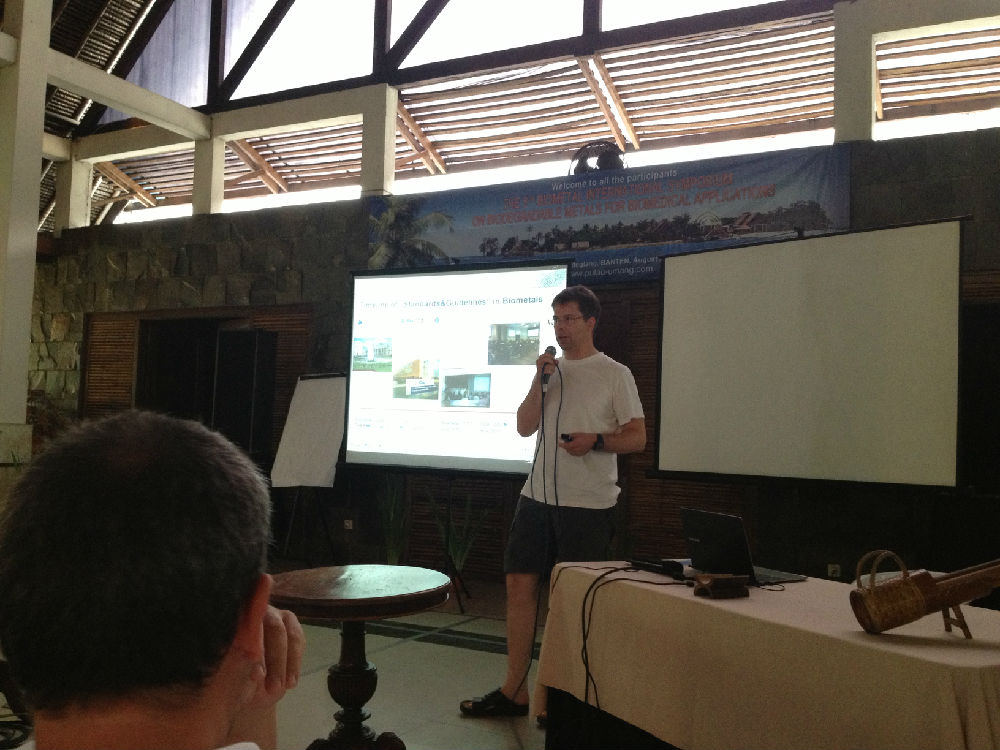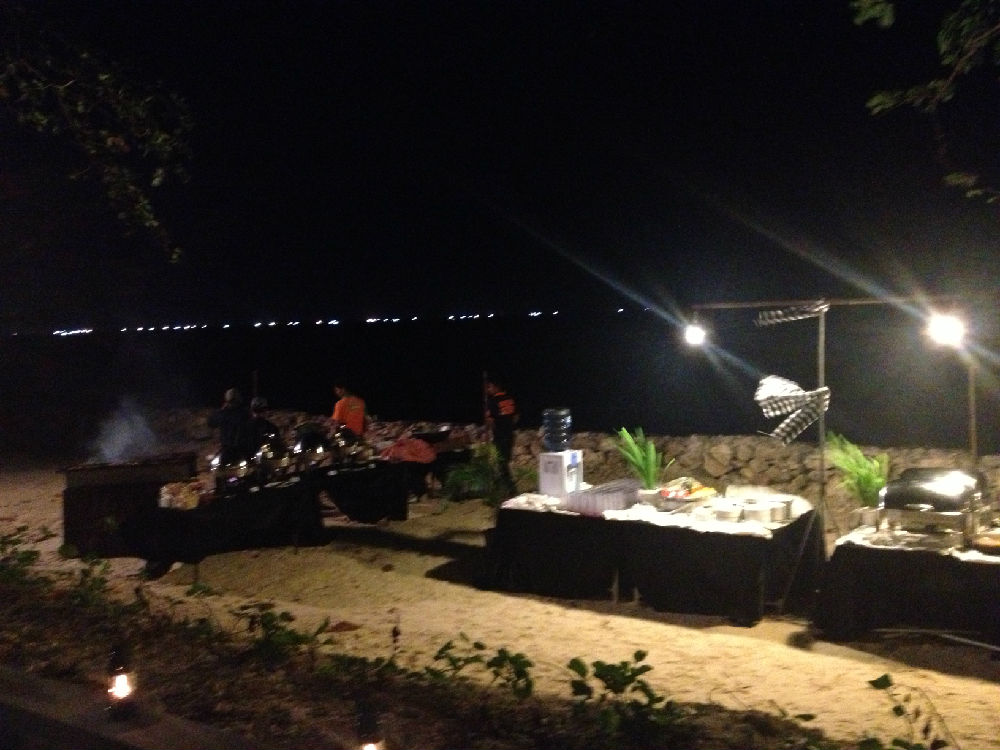博文
5th Biometal 印度尼西亚 记录--Day 6
||
In vivo session
O18. MRI based perfusion measurements inbone after implantation of biodegradable magnesium rods
Witte F, Bobe K, Meier M
Julius Wolff Institut, Charité - Universitätsmedizin Berlin, Berlin,Germany
Why do we need to know the local perfusion?
CR is depending on flow rate in in vitro systems
In vivo shear stress : 0.68MPa
CR is depending on the local environment
Clearance depends on local blood flow
It is necessary to know the local perfusion to creat “in vivo like”system
Mouse perfusion bone 2.3ml/100g/min
Rabbit bone 19.1 ml/100g/min
RAT femur 8-51 ml/100g/min
Tibia 7-37 ml/100g/min
Arteral-spin labeling
FAIR(flow-sensitive alternating inversion recovery)
Magnetic Resonance in miedicine 2006, vol.5 108-115
In vivo measurement of perfusion, diffusion and structural changes
Witte European Cells and Materials vol.23, supl.2, 2012
植入鼠骨髓腔10天后血液灌注回到原来水平
Perfusion is depending on species, anatomical location, postoperativetime point
ASL-FAIR MRI sequences are powerful tool to discover: effect ofoperation method, effect of implantation site, postoperative changes in aspecific anatomical site, on local vasculariztion and tissue perfusion
O16. Implant location strongly influencesdegradation and applicability of magnesium alloys for orthopaedic application
Reifenrath J, Roessig C, Wolters L, SeitzJM, Helmecke P, Angrisani N
Small Animal Clinic, Veterinary University of Hannover, Foundation,Hannover, Germany
Bone remodeling process:
Intramedullary pin<intermedullary nail<plate screw system
Results cannot be generally transferred between different applicationarea
O17. The degradation behavior ofMg-3Zn-0.5Zr alloy inan in vitro and in vivo environment
Zhang J, Bi YZ, Chen MF, Huang Y
School of Materials Science and Engineering, Tianjin University ofTechnology, Tianjin, China
Mg-3Zn-0.5Zr, Mg-4Zn-0.5Zr, Mg-5Zn-0.5Zr
O19. In vivo study of iron-basedbiodegradable metals using rat model
Purnama A, Drolet M-C, Couet J, Mantovani D
Institut Universitaire de Cardiologie et de Pnemulogie de Québec,Department of Medicine, Laval University, Canada
316L SSElectroform-Fe A-FeFe-35Mn disc 0.5mm in diameter
1,3 months
Degradation by the presence of fibrious, neovascularization and indicationof inflammatory cells
W4. Coatingtechnologies for corrosion protection of Mg
Prof. Shaokang Guan
School of Materials Science and Engineering, Zhengzhou University,Zhengzhou, China
Biocomposite coating on fluoride coating by PED and TED
inorganic coating for Mg alloystent
Mg-Zn-Y-Nd alloy stent
The grain size was greatly refined to 1 micrometer and nano-particlesuniformly distributed in grains by cyclic extrusion compression.
Density : 1.780 YS: 185MPa UTS 330MPa poisson ratio 0.31, modulus: 42GPa
Metal coverage 3.5mm diameter: 18.62%
Axial recoil rate < 2%
Radial recoil <
TiO2 coating on Mg alloy stens
Inert-good corrosion resitance
Semiconductor antithrombogenic poperties
Prevent hyperplasia (0=30days), increase endothelioid cell adhension anfgrowth (1-2 months)
MgF2+TiO2+Drug,
MgF2 treated with Hf with 24 hours
Nano TiO2 : hydrothermal treatment to obtain anatase TiO2 coating withthe thickness 0.5-1 micrometer
In situ growth of TiO2 on MgF2 , with Hf/NH4F increasing
Drug Rapamycin spraying on top of the above inorganic coating
Hemolysis ratio for bare Mg alloy, nanosheet, nanoparticle, rapamycin47%, 2,7%, 1%, 0.5%
SOP35. Distribution of Fe-based degradablematerials in mice skeletal muscle
Paramitha D, Estuningsih S, Noviana D, UlumMF, Hermawan H
Faculty of Veterinary Medicine, Bogor Agricultural University (IPB),Indonesia
Cr-coated Fe wire 3.0, 1.0mm
SOP36. Degradation of Fe-bioceramiccomposites at two different implantation sites in sheep animal model observedby X-ray radiography
Noviana D, Nasution AK, Ulum MF, Hermawan H
Faculty of Veterinary Medicine, Bogor Agricultural University (IPB),Indonesia
5wt%HA/TCP/BCP
5*2*0.5mm
SOP37. Monitoring of early biodegradation ofFe-bioceramic composites by B-mode ultrasonography imaging in sheep animalmodel
Noviana D, Nasution AK, Ulum MF, Hermawan H
Faculty of Veterinary Medicine, Bogor Agricultural University (IPB),Indonesia
2D-B-mode ultrasonography at day 3, 9 and 14 days of implantation
SOP38. In vitro and in vivo charaterizationof a nitrided iron coronary stent
Zhang DY, Gao RL, Lin WJ, Qin L, Zhang G,Cao P, Qiu H, Wang GQ, Xia Y
R&D Lab, Lifetech Scientific (Shenzhen)Co.,Ltd, China
Plasma nitriding technology
The compound layer should be removed by polishing
Strut : 70+-5micrometer
Degradation 4 years
SOP39. Metal ion level and polymorphonuclearleukocyte cells number as determination factors for early in vivo rejection ofbiodegradable metals
Ulum MF, Paramitha D, Estuningsih S, NovianaD, Hermawan H
Faculty of Veterinary Medicine, Bogor Agricultural University (IPB),Indonesia
Measuring the level of Fe ion in the blood
PLM cell numbers indicate that the composite were not rejected by thesheep
SOP40. In vivo Models for the Evaluation ofDegradable Metallic Biomaterials for Orthopaedic Applications
Dias GJ, Walker J
Department of Anatomy, University of Otago, Dunedin,New Zealand
SOP41. The role of magnesium and associatedalloying elements in human physiology and biology
Qin L
Musculoskeletal Research Laboratory, Department ofOrthopaedics, The Chinese University of Hong Kong, Hong Kong SAR, China
SOP42. Experimental study on stentimplantation for congenital tracheal stenosis in infants and children
Xue BD, Lu ZH, Yuan GY, Xu ZW
Shanghai Children’s Medical Center, Shanghai Jiaotong University(SJTU)School of Medicine, Shanghai, China
Cell culture by rabbit tracheal epithelial cell
气管支架
下午
W6. In vivo models for orthopaedic andcardiovascular applications - selection and implementation
Dr. George Dias
Department of Anatomy, University of Otago, Dunedin, New Zealand
Why in vitro and in vivo evaluation?
To determine biocompatibility, safety and mechanical stability
In vitro testing& limitations
First stage test for acute toxicity & cytocompatibilty
Obtain information: cell proliferation, viability& differentiation
Screening for products qulity& potentially harmful contaminants
Not able to demonstrate tissue response
Cyttotoxicity/compitabilty vary between cell lines and passage number
Overestaimate toxicity, limited to acute cytocompatiiblity
Difficult to mimic/control dynamic properties& cell interactions
In vivo models for orthopedic applications
Inevitable for biomaterial designed gor prthopethic application
Particularly behavior of degradable metals—to access corrosion behaviorand biocompatibility
Interlinked-corrosion products having local
Rodent---can involve subcutaneous, intermuscular or intramuscular locationsin small animals
In vivo testing in soft tissues
Critical size bone defect evaluation
Desirable attributes of an animal models
Standardization & Regulation Update
Prof. Frank Witte
Julius Wolff Institut, Charité - Universitätsmedizin Berlin, Berlin,Germany

Timeline of standard®ulation in biometals
Biometal 2009
FDA March 2012
Biometals 2012, Maratea
FDA ASTM Nov 2012
DIN Nov. 4, 2013 Workshop on Biodegradable Metals, Berlin Germany
US-FDA requests: Report systemic toxicity of Biometals!
i.e., Weight loss of the animal, some signs of the animal organ changes
Solutions for a better in vitro – in vivo correlation
ISO/TC 150/SC 2/WG 7 Cardiovascular absorbable implants
Challenges with current ISO testing
Cytotoxicity testing according to ISO 10993-5
72h incubation for extract tests
Wxtraction volume based on sample surface or weight
Animal test according to ISO 10993-6
Implantation in dynamic environment for X week
Which in vivo time period is your in vitro experimental resembling?
基于GAP in results,可以反过来想:先在动物体内植入一段时间,取出然后称重变化,再来做体外实验找到对应这个重量变化的对应体外实验时间点
ED min, Mininium Extract dilution, ED cyto, Ed max, maximum Extract dilution
Safety factor= ED cyto/Ed max
Closing Remarks
Prof. Diego Mantovani
Lab. for Biomaterials & Bioengineering (CRC-I), Dept.Min-Met-Materials Engineering & University Hospital Research

晚餐的BBQ,有烤鱼和烤虾吃
https://wap.sciencenet.cn/blog-39092-721348.html
上一篇:5th Biometal 印度尼西亚 记录--Day 5
下一篇:5th Biometal 印度尼西亚 记录--Day 7